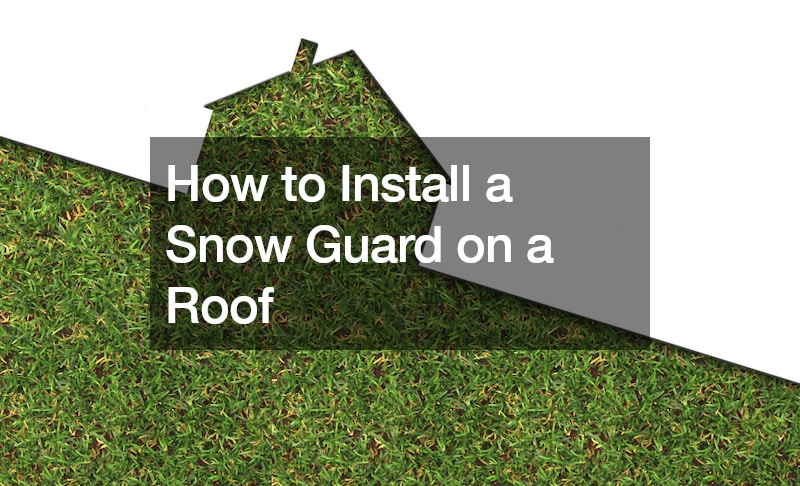
In regions where snowfall is a common occurrence, protecting your property from the potential hazards posed by accumulated snow and ice is crucial. One effective solution is the installation of snow guards on roofs, also known as gutter snow guards. These devices are designed to prevent snow and ice from sliding off the roof all at once, reducing the risk of injury to pedestrians below and preventing damage to gutters, landscaping, and other areas surrounding the building.
Choosing the Right Snow Guard:
Before embarking on the installation process, it’s essential to select the appropriate type of snow guard for your roof. Snow guards come in various styles, including pad-style snow guards, pipe-style snow guards, and fence-style snow guards.
Each type offers unique benefits and installation requirements, so it’s essential to consult with a roofing professional to determine the best option for your specific needs.
Assessing the Roof:
Before installing snow guards, it’s crucial to assess the roof’s structure and condition to ensure compatibility with the chosen snow guard system. A thorough inspection should be conducted to identify any areas of concern, such as loose or damaged roofing materials, inadequate flashing, or structural weaknesses. Addressing these issues beforehand will help ensure the effectiveness and longevity of the snow guard installation.
Preparing for Installation:
Once the roof has been assessed and any necessary repairs or reinforcements have been made, it’s time to prepare for the snow guard installation. This typically involves gathering the necessary materials and tools, including snow guards, screws, adhesive, sealant, and safety equipment such as harnesses and ladders. Additionally, consulting the manufacturer’s instructions and following local building codes and regulations is essential to ensure compliance and safety throughout the installation process.
Installing the Snow Guard:
The installation process for snow guards may vary depending on the chosen style and manufacturer’s recommendations. However, the general steps typically involve the following:
Placement: Determine the optimal placement of the snow guards on the roof to provide adequate coverage and protection. Factors such as roof pitch, snow load, and architectural features should be considered when positioning the snow guards.
Attachment: Secure the snow guards to the roof surface using screws or adhesive, ensuring they are firmly anchored to the underlying structure. It’s crucial to follow the manufacturer’s guidelines regarding spacing, fastener type, and installation method to achieve optimal performance.
Sealing: Apply a waterproof sealant or adhesive around the base of each snow guard to create a watertight seal and prevent water infiltration beneath the roofing materials. This step is essential for maintaining the integrity of the roof and preventing leaks or damage over time.
Reinforcement: For added stability and durability, consider reinforcing the snow guard installation with additional supports or braces, particularly in areas prone to heavy snow loads or high winds. This will help ensure the snow guards remain securely in place during inclement weather conditions.
Maintaining Snow Guards:
Once installed, snow guards require regular maintenance to ensure continued effectiveness and performance. Periodic inspections should be conducted to check for any signs of damage, corrosion, or loosening of fasteners. Additionally, removing accumulated snow and debris from the snow guards as needed will help prevent excess weight and ensure proper drainage on the roof.
How do Snow Guards work?
Snow guards serve as essential roofing accessories designed to prevent the sudden release of accumulated snow and ice from rooftops, which can pose safety hazards and cause damage to property below. But how exactly do these devices work?
At its core, the function of a snow guard is relatively simple yet highly effective. When snow accumulates on a roof, it forms a blanket of weight that can become unstable over time, especially as temperatures fluctuate and snow begins to melt and refreeze. Without proper containment, this accumulated snow can suddenly slide off the roof in large, potentially dangerous sheets, posing a risk to pedestrians, vehicles, and nearby structures.
Snow guards work by interrupting the natural flow of snow and ice on the roof, preventing it from sliding off all at once. By strategically placing snow guards along the roof’s surface, typically in areas prone to snow accumulation or where snowmelt tends to occur, the snow guard system creates barriers that help distribute the weight of the snow more evenly. This redistribution of weight helps stabilize the snowpack, reducing the likelihood of sudden avalanches and minimizing the risk of damage or injury.
There are various types of snow guards available, each offering unique designs and installation methods tailored to different roofing materials and configurations. Pad-style snow guards, for example, feature flat, rectangular plates that are attached directly to the roof surface, while pipe-style snow guards consist of cylindrical tubes or rods that are spaced along the roof’s edge. Fence-style snow guards, on the other hand, form continuous barriers that run parallel to the roof’s ridgeline, providing comprehensive coverage and protection.
Regardless of the specific style or design, the primary goal of a snow guard is to create friction and resistance against the downward movement of snow and ice, allowing it to gradually melt and drain off the roof in a controlled manner. By preventing sudden snow slides and ice dams, snow guards help maintain the integrity of the roof and ensure the safety of individuals and property below, making them essential components of any snow management strategy for residential and commercial buildings alike.
Conclusion:
Installing snow guards on a roof is a proactive measure to protect your property and enhance safety during winter weather conditions. By selecting the right snow guard system, properly preparing the roof, and following the correct installation procedures, you can mitigate the risks associated with snow and ice buildup and safeguard your home or building against potential damage. Consult with a roofing professional to determine the best snow guard solution for your specific needs and ensure a successful installation that provides lasting protection year after year.
.

